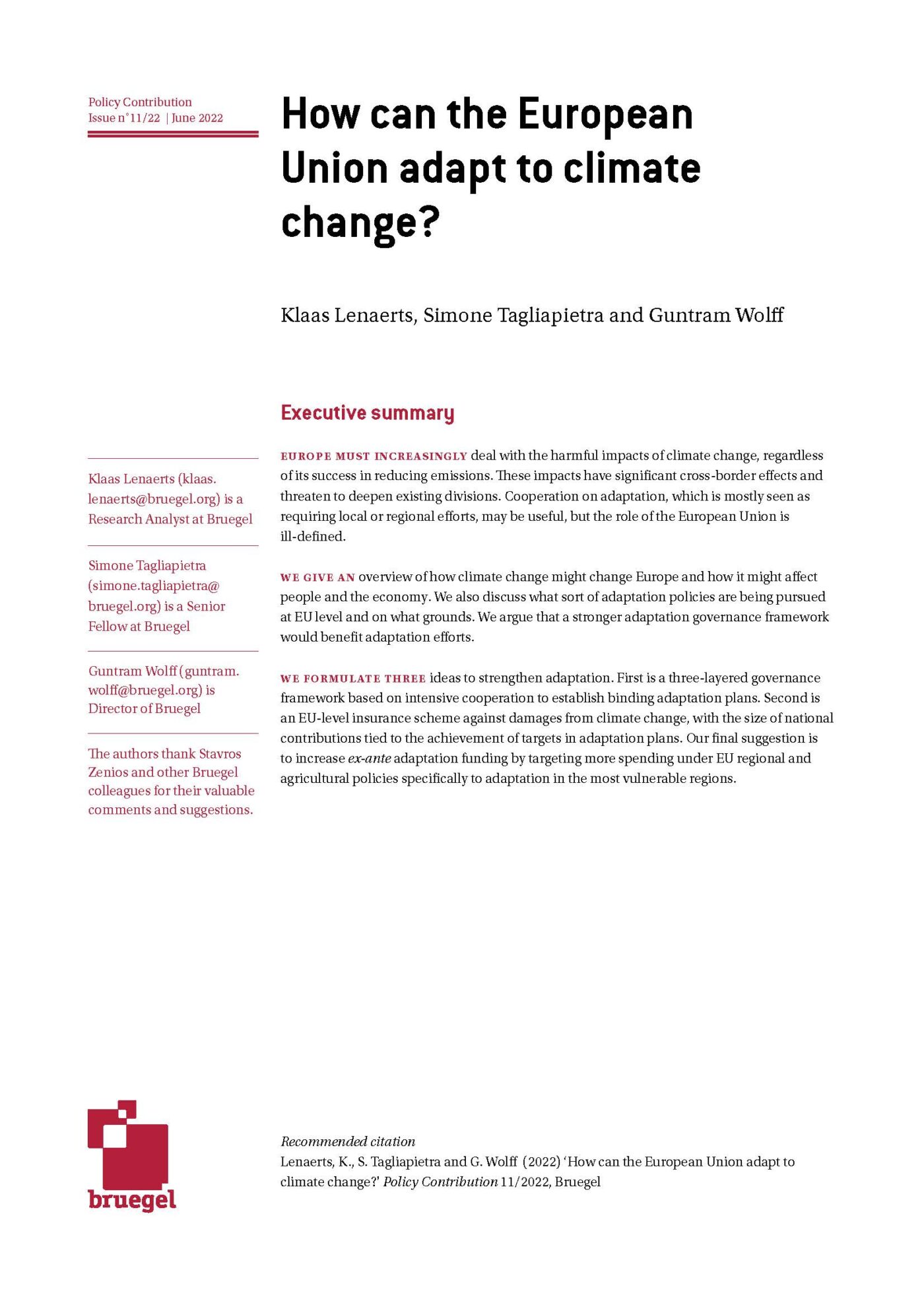Blog Post
One last push is needed to improve the Just Transition Fund proposal
The European Parliament and the Council still have an opportunity to improve the Just Transition Fund by refocusing it on social support and basing fund allocations on more granular information that takes into account not only countries’ needs but also their green ambitions.
The Just Transition Fund (JTF), one of the three pillars of the Just Transition Mechanism, aims at providing assistance to EU territories most negatively affected by the transition to a climate-neutral economy. Given the socio-economic strain caused by the COVID crisis since the mechanism was unveiled in January 2020, the European Commission proposed last month to increase its funding more than fivefold, from €7.5 billion to €40 billion (unless otherwise specified, 2018 prices are used).
(…) the EU political bodies – Council and Parliament – can still further amend it to better respond to the urgent need for just transition policies in the challenging context of the post-COVID recovery
The newly amended proposal for a JTF is a part of the proposed €750-billion ‘Next Generation EU’ instrument, a key element of the Commission’s overall recovery package. It is justified by the need to accelerate the green transition while avoiding an increase in national and regional disparities to “create the conditions for Europe’s long-term growth and resilience”. While the revamped proposal has been hailed as one of the Commission’s landmark proposals for recovery, the EU political bodies – Council and Parliament – can still further amend it to better respond to the urgent need for just transition policies in the challenging context of the post-COVID recovery.
The three main amendments to the JTF proposal
- A fivefold increase in the size of the JTF
In the new proposal, the JTF will amount to €40 billion. €10 billion will come from the 2021-2027 budget and €30 billion from the ‘Next Generation EU’ instrument, which will be financed by issuing EU debt. This second source of funding will be made available for budget commitments at the rate of roughly €7.5 to €8 billion per year between 2021 and 2024.
- Adjustments to the pre-allocation method
Though very similar to what was originally proposed, the method is adjusted to reflect the additional funding made available for the JTF. The maximum pre-allocation for a country is capped at €8 billion instead of €2 billion and the minimum pre-allocation is set at €32 of a country’s per capita aid intensity over the whole period, instead of €6.
Figure 1 shows how these modifications impact both the amount and the share each country receives. Given the increased overall funding, all countries mechanically get a greater pre-allocation. Their shares of the total remain roughly the same, with the exception of Poland. While it remains the main beneficiary of the fund – now receiving €8 billion, more than the €7.5 billion initially proposed for the entire EU – its share has now dropped from over a quarter of the total to one-fifth of the total.
- Amended mandatory transfers from other structural funds
In the original proposal, a country had to match each €1 it received from the JTF with between €1.5 and €3 from envelopes allocated to them through the European Regional Development Fund (ERDF) or the European Social Fund Plus (ESF+). These mandatory transfers meant that the €7.5 billion of direct funding from the JTF translated into JTF country envelopes up to four times larger than the original amount received.
In the amended regulation, only the part of JTF’s funding which comes from the 7-year budget – €10 billion – must be matched in the same way. The remaining €30 billion of funding from the recovery instrument does not need to be matched.
The Commission’s amendments: a too timid step forward
In our April 2020 study, we assessed the Commission’s original proposal for a JTF. One of the main points that came to light was the severe lack of funding for the initiative, especially considering its ambitious objectives: ensuring social support, economic repositioning and development, as well as environmental rehabilitation and repurposing in EU regions hardest hit by the transition.
Estimating exactly how much funding a just transition to climate neutrality will require is a complex exercise. A rough lower-bound estimate of the needs for the energy sector by itself could be around €10.8 billion – already more than the JTF’s entire original envelope. The significant increase in funding proposed for the JTF is therefore very welcome as it will allow funding and implementation of more ‘just transition’ projects in transitioning regions. However, €40 billion is still likely not enough to ensure a just, EU wide transition to climate neutrality. The progress of transitioning territories should be closely monitored, and the Council and the Parliament should be ready to increase the JTF’s budget should this prove necessary – much like what was done for the Youth Employment Initiative in 2016.
€40 billion is still likely not enough to ensure a just, EU wide transition to climate neutrality
In its amended proposal, the Commission restricts transfers from other structural funds to only match the JTF’s €10 billion funding from the EU’s budget rather than the whole envelope of €40 billion. The Commission’s amended proposal justifies this as a way to “preserve the capacity of Member States and regions to use their cohesion policy resources to support economic, social and territorial cohesion”. Transfers to match the original allocation of €7.5 billion were already a contentious point of the regulation, as there was some worry about removing funds from cohesion envelopes – a sentiment echoed in the European Parliament’s draft report on the JTF regulation which called for the removal of these transfers.
Our study highlighted the high likelihood that, by the end of negotiations on the multiannual financial framework, the money allocated to the JTF will not really be additional, but instead taken from other structural funds. If this were to happen, it would translate into a partial reallocation of €40 billion from countries favoured by the use of GNI per capita as a criterion – mainly Italy, Spain, Portugal and Hungary – to countries favoured by the use of carbon intensity as a criterion – mainly Poland, Germany, Czech Republic and Bulgaria.
Three proposals to enhance the proposal
- Amend the scope of project eligibility under the JTF
While the diversity of the JTF’s scope of support gives regions some flexibility in designing their transition strategies, limited funding constrains the number of objectives that can realistically be achieved. Our study therefore recommended to refocus the JTF on social support for populations in transitioning territories and, to a lesser extent, on land restoration. While it might be politically difficult at this stage of the negotiations to narrow the JTF’s scope to social support and land restoration only, some amendments could be made to at least strengthen its ‘social support’ branch:
- Make funding for reskilling and upskilling projects conditional on real local labour market needs, as was done with the Scottish Transition Training Fund.
- Support activities that develop a region’s capacity to collect, harmonise and disseminate labour data related to skills needed and areas where affected workers could find alternative jobs.
- Include income support for transitioning workers: pension bridging grants, or mobility grants for workers who need to move for a new job. Given the extent of the social safety nets in most EU countries, this would only be a complement to national safety nets, where necessary.
While it might be politically difficult at this stage of the negotiations to narrow the JTF’s scope to social support and land restoration only, some amendments could be made to at least strengthen its ‘social support’ branch.
- Simplify and refocus the allocation methodology
As it stands, the pre-allocation of JTF funds is based on two criteria: on the one hand, the identification of carbon-intensive regions; and on the other, various data on employment in coal and lignite mining; in the production of peat and oil shale; and overall industry employment in carbon-intensive regions. This formula is meant to measure countries’ transition needs and distribute funds accordingly.
When we reproduced the Commission’s pre-allocation calculations, both before and after amendments, we found major limitations in the methodology (details of our calculations and conclusions can be found in our study). Firstly, the data on which results are highly dependent is quite unstable. Additionally, the weights given to the two criteria included in the pre-allocation formula do not reflect their actual impact on the final result. This is because both criteria are highly correlated, so giving weight to one or the other is ultimately indifferent. This could be corrected by using only one criterion: the level of carbon intensity. This would substantially simplify the formula and make the calculations more straightforward and transparent.
Beyond just needs, funds pre-allocation could however also take into account a country’s willingness to engage in the transition process, for example by including a new criterion in the pre-allocation formula: the ambitiousness of the countries’ transition strategies submitted to the Commission (“Territorial Just Transition Plans”). This could encourage higher levels of ambition, in line with the European Parliament’s proposal that the “speed with which Member States commit to reducing their greenhouse gas emissions from coal or lignite, as reflected in the respective 2030 National Energy and Climate Plans” be added as a criterion for the pre-allocation of the JTF.
- Change the pre-allocation method to capture more granularity
The EU uses a hierarchical territorial classification system known as the NUTS classification. NUTS1 captures major socio-economic regions and is the largest classification in this system, while NUTS3 is the most granular, capturing very small regions.
The pre-allocation formula in the JTF currently uses NUTS2-level data, even though countries’ Territorial Just Transition Plans identify territories based on their transition needs at a NUTS3 level, or even at the more granular level of territories or cities. This creates a gap between countries’ needs, as calculated by the pre-allocation formula, and the needs of their regions as identified in the plans. Figure 2 illustrates the discrepancies between NUTS2 and NUTS3 regions identified as highly carbon intensive in the Commission’s methodology. The map on the right shows small NUTS3 regions that are highly carbon intensive and would require funds but may not be taken into account in the calculation as they are located within a broader NUTS2 region which is not considered to be carbon intensive.
While data availability at this level could potentially be an issue, our study shows that the current methodology could be changed to the level of NUTS3 regions without much difficulty.
Conclusion
Overall, the European Commission’s amendments to increase the size of the JTF is welcome but the European Parliament and the Council could improve the proposal in two main ways. First, the JTF could be refocused on social support, especially by ensuring that trainings meet local labour needs and by enabling JTF funding for mobility and pension bridging grants that would complement national social safety nets. Second, country pre-allocation should reflect both transition needs and ambition in an accurate and granular way. Including ambition as a criterion for pre-allocation and using NUTS3-level data rather than NUTS2-level data would work in this direction.
Recommended citation
Cameron, A., G. Claeys, C. Midões, S. Tagliapietra (2020) ‘One last push is needed to improve the Just Transition Fund proposal’, Bruegel Blog, 11 June, available at https://wordpress.bruegel.org/2020/06/one-last-push-is-needed-to-improve-the-just-transition-fund-proposal/
Republishing and referencing
Bruegel considers itself a public good and takes no institutional standpoint. Anyone is free to republish and/or quote this post without prior consent. Please provide a full reference, clearly stating Bruegel and the relevant author as the source, and include a prominent hyperlink to the original post.











